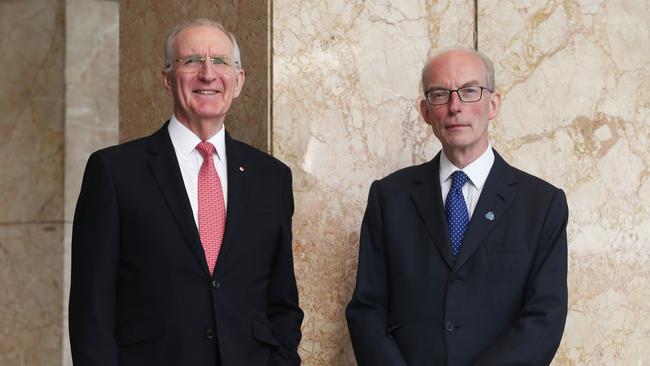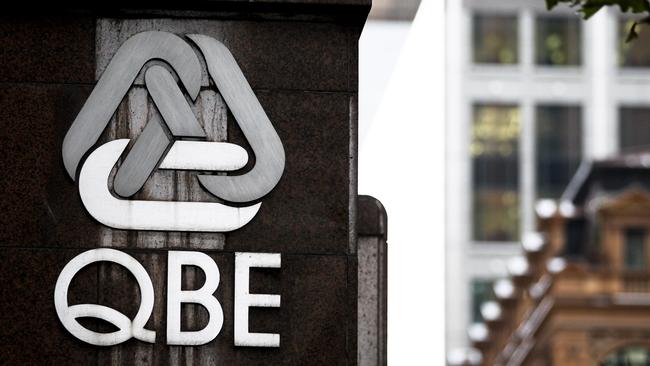ASX-listed Insurer QBE flags premium price rises as profits double
Large premium increases in Australia helped lift QBE’s profit as it now attempts to improve returns from its North American operation.

Fewer disasters and more competition is expected to see ASX-listed commercial insurer QBE slow stiff price rises, as it unveiled a 101 per cent profit bounce to $US802m ($1.2bn).
QBE said its profit uplift, which fell short of analyst expectations, came as it enjoyed a return to lower levels of natural catastrophe losses while still passing through premium price rises across its book.
But QBE, which writes two thirds of its business outside Australia, flagged an end to a long tail of claims from its North American operations, announcing a deal to offload them and free up capital.
The profit uplift, hitting US$777m on an adjusted basis, came after QBE posted $US405m adjusted profits last year for the same period.
Gross written premiums were up 2 per cent across the first half, hitting $US13.05bn, while renewal rate increases passed through to customers were up a further 6.7 per cent.
Premium increases were most noted for QBE’s Australia Pacific customers, slugged with 9.9 per cent lifts, while the insurer’s international customers saw only 4.8 per cent increases.
QBE, which reports its results in US dollars, writes almost two thirds of its business outside Australia.
The insurer said it was targeting a further 3 per cent lift in gross written premium for the full year.
QBE group chief executive Andrew Horton said the insurer was facing more competition in its global business, with a recovery in Australian insurance markets also tempting more global insurers back into the fight.
Mr Horton said QBE was now competing against Lloyd’s insurers, which were back playing in Australia markets after years of poor returns.
“Local players also like the business we’ve got in commercial packages and farms here in Australia and therefore are being more competitive,” he said.

QBE largely writes commercial cover, with the insurer often exposed to global conflicts or disasters.
The unrest in New Caledonia and collapse of the Baltimore Bridge in the US, after being hit by a freight ship, were two key disasters to hit QBE in the half.
This came as catastrophe costs were trimmed to US$527m for the half, down 8.7 per cent on the prior period.
But Mr Horton said QBE did not expect to see significant claims from the CrowdStrike outage, which crippled global computers on July 20.
Australia is one of the few markets QBE still plays in home and motor insurance, a market
Mr Horton noted remained challenging with no underwriting profit for a number of years.
But despite that Mr Horton said home and motor “can still be a reasonable market business”, noting he was conscious of affordability challenges for many Australians.
QBE’s North American mid-market operations have proved challenging for the insurer, with repeated disasters and long tails of claims dragging on the global insurer.
In response QBE has moved to offload a string of these policies in a deal with Nasdaq-listed Enstar and UK insurer Riverstone Internatioal aimed at de-risking $1.6bn in reserves, or 10 per cent of QBE’s total net reserves, and reducing risks associated with running off the North American non-core lines.
Mr Horton said he hoped the deal would be the last the insurer did to cauterise past claims.
“I would never say never, the aim is not to do one next year because it means we’ve created some reserves we’re concerned about,” he said.
QBE told investors the loss portfolio transaction was likely to cost around US$85m before tax.
The insurer said the deal with QBE said this would deliver a $230m net capital benefit.
This marks the second time QBE has entered into a deal with Enstar to cover past claims.
Mr Horton said roll-off of the North American middle market business, announced in June, would allow QBE to refocus its strategy to “businesses which hold more meaningful market position, relevance and scale”.
The insurer has also walked away from its Vanuatu operations, closing the business on July 31.
QBE’s net claims ratio was trimmed over the half, slumping to 64.2 per cent down from 69 per cent in 2023.
The insurer’s combined operating ratio, a central measure of its performance, was 93.8 per cent, an improvement on the 98.8 per cent posted in the prior period.
QBE said it was targeting a 93.5 per cent combined operating ratio for the full year. The insurer said it would declare a 24c dividend, with 4.8c franked.
This takes QBE’s total interim payout to $360m, up on the $209m paid last year.
UBS analyst Scott Russel said QBE had presented a “disappointing outcome considering recent repricing levels”.
QBE shares closed down 1.71 per cent to $16.05.






To join the conversation, please log in. Don't have an account? Register
Join the conversation, you are commenting as Logout